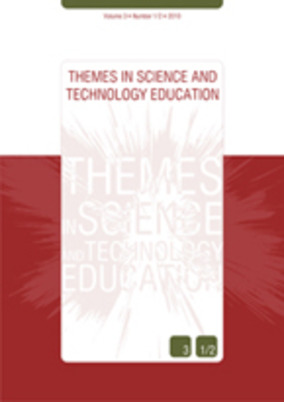The impact of feedback on phonological awareness development
Part of : Themes in science and technology education ; Vol.7, No.2, 2014, pages 137-149
Issue:
Pages:
137-149
Author:
Abstract:
The utilization of Information and Communication Technologies (ICT) in educational practice is indispensable, while it becomes imperative in the education of individuals with special educational needs, as it promotes the application of Individualized Education Programs.Feedback in digital activities aiming at phonological awareness development isthe topic under consideration in the present paper.The studyhas twoobjectives.On the one hand to studyfeedback as a differentiating factor fordyslexia intervention through the use of ICT and on the other handto search for the type of feedback that helps students with dyslexia the most.Thetwo different feedback typesare based onbehavioristand constructivist approaches.Results show that constructivism is the theoretical model that feedback has to be based on, in order activities to be fruitful to students with dyslexia.
Subject:
Subject (LC):
Keywords:
ICT, dyslexia, feedback, behaviorism, constructivism
References (1):
- Adam T., & Tatnall, A. (2008). Using ICT to improve the education of students with learning disabilities. In M. Kendall & B. Samways (eds.), Learning to Live in the Knowledge Society (pp. 63-70). Boston: Springer.Bruner, J. S. (1970). Some theories on instruction. In E. Stones (ed.), Readings in Educational Psychology. Learning and Teaching (pp. 112-124). London: Methuen.Chang, C.-Y., & Wang, H.-C. (2009). Issues of inquiry learning in digital learning environments. British Journal of Educational Technology, 40, 169–173.Day, K. (1995). Feedback on teaching. In F. Forster, D. Hounsell & S. Thompson (eds.), Teaching tutoring and demonstrating: A handbook (pp. 79-88). Edinburgh: Centre for Teaching, Learning and Assessment.European Commission (2000). European Report on the Quality of School Education. European Communities.Geoff, P. (2004). Teaching today: a practical guide. Cheltenham: Nelson Thornes.Hartley, J. (2007). Teaching, learning and new technology: a review for teachers. British Journal of Educational Technology, 38(1), 42-62.Jonassen, D. H., & Land, S. M. (2000). Theoretical Foundations of Learning Environments. London: LEA.Kazakou, M., Soulis, S., Morfidi, E., & Mikropoulos, T. A. (2011). Phonological awareness software for dyslexic children. Themes in Science and Technology Education, 4(1), 35-54.Lerner, R. M. (2002). Concepts and Theories of Human Development. Mahwah, NJ: Erlbaum.Lundberg, I. (1995). The computer as a tool of remediation in the education of students with reading disabilities: A theory based approach. Learning Disabilities Quarterly, 18, 89-99.Lynch, L., Fawcett, A. J., & Nicolson, R. I. (2000). Computer assisted reading intervention in a secondary school: an evaluation study. British Journal of Educational Technology, 31(4), 333-348.MacBeath, J. (1999). Schools must speak for themselves: The case for school self-evaluation. London: Routledge.Marsh, J., & Singleton, C. (2009), Editorial: Literacy and technology: questions of relationship. Journal of Research in Reading, 32, 1–5.Mayer, R. E. (2002). Cognitive theory and the design of multimedia instruction: An example of the two way street between cognition and instruction. New Directions for Teaching and Learning, 89, 55-71.Morfidi, E., Mikropoulos, T. A., & Bellou, I. (2012). Teaching intervention through a hypermedia application for children with learning and communication difficulties. Procedia Computer Science, 14, 419-427.Mory, E. H. (1992). The use of informational feedback in instruction: Implications for future research. Educational Technology Research and Development, 40(3), 5-20.Mory, E. H. (1995). A new perspective on instructional feedback: From objectivism to constructivism. Paper presented at the Annual Meeting of the Association for Educational Communications and Technology. Anaheim, CA.Mory, E. H. (2004). Feedback research revisited. In D. H. Jonassen (ed.), Handbook of Research on Educational Communications and Technology (pp. 745-783). Mahwah, NJ: Lawrence Erlbaum.Nicolson, R., Fawcett, A., & Nicolson, M. (2000). Evaluation of a computer-based reading intervention in infant and junior schools. Journal of Research in Reading, 23(2), 194–209.Olson, R. K., & Wise, B. (2006). Computer-based remediation for reading and related phonological disabilities. In M. C. McKenna, L. D. Labbo, R. D. Kieffer, & D. Reinking (eds.), International handbook of literacy andtechnology (vol. II, pp. 57-74). Mahwah, NJ: Lawrence Erlbaum Associates.Rivera, D., & Smith, D. (1997). Teaching students with learning and behavior problems. Boston: Allyn & Bacon.Sherman, T., & Kurshan, B. (2005). Constructing learning. Learning & Leading with Technology, 32(5), 10-39.Schunk, D. H. (1989). Social cognitive theory and self-regulated learning. In B. J. Zimmerman & D. H. Schunk (eds.), Self-regulated learning and academic achievement: Theory, research and practice (pp. 83-110). New York: Springer-Verlag.Singleton, C. H. (1991). Computer applications in the diagnosis and assessment of cognitive deficits in dyslexia. In C. Singleton (ed.), Computers and literacy skills (pp. 149-159). Hull: Dyslexia Computer Resource Centre, University of Hull.Soulis, S.-G. (2009). Effective special teacher characteristics: perceptions of preschool special educators in Greece. European Journal of Special Needs Education, 24(1), 91-101.Tijms, J. (2004). A process-oriented evaluation of a computerised treatment for dyslexia. Educational Psychology, 24(6), 767-791.Tijms, J. & Hoeks, J. (2005). A computerized treatment of dyslexia: benefits from treating lexico-phonological processing problems. Dyslexia, 11, 22-40.Thorndike, E. L. (1913). Educational Psychology: The Psychology of Learning. New York: Teachers College Press.Torgesen, J. K. (1986). Computer-assisted instruction with learning disabled children. In J. K. Torgesen & B. Y. Wong (eds.), Psychological and educational perspectives on learning disabilities (pp. 417-433). Orlando, FL: Academic Press.




